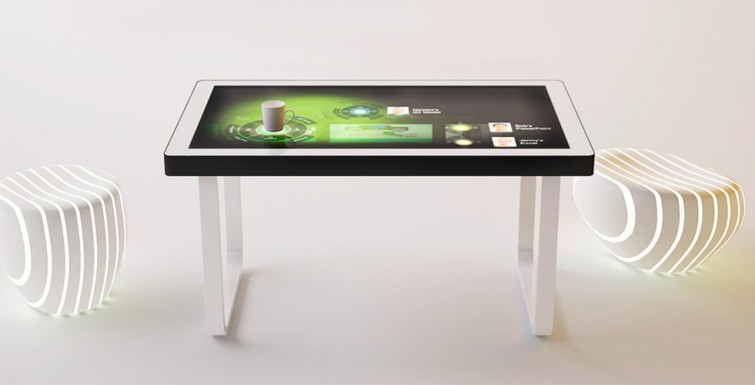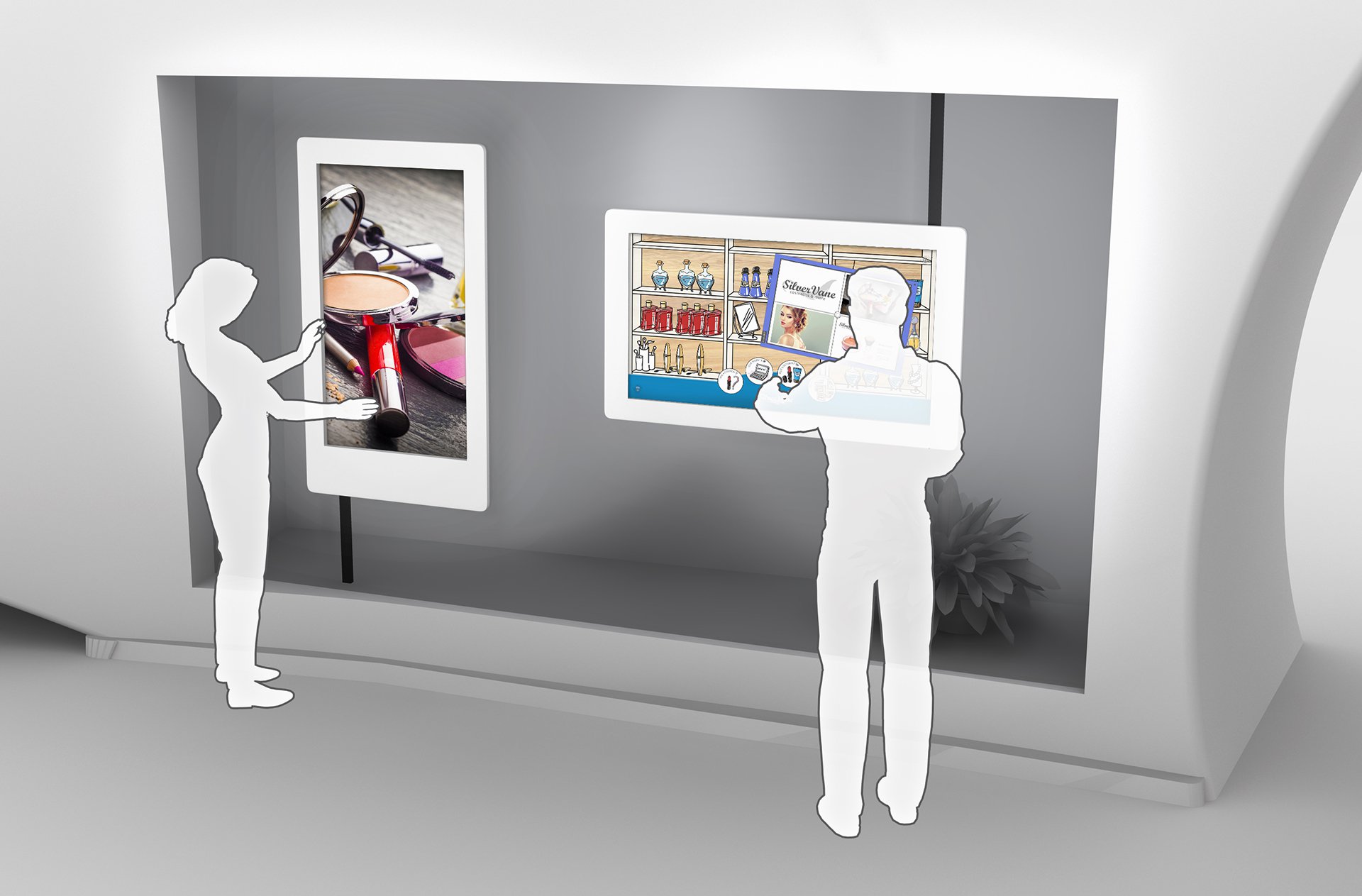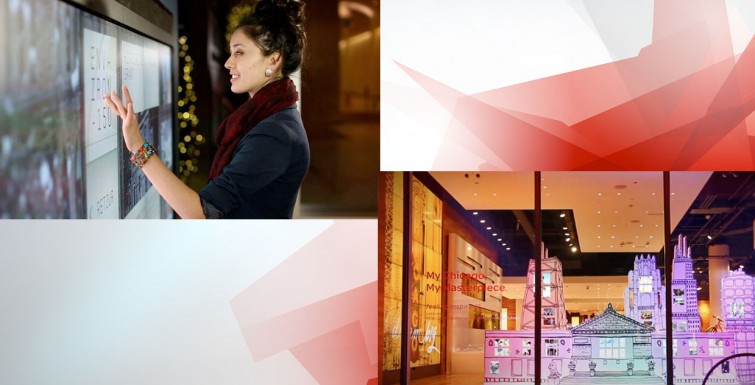As digital signage is an inherently visual medium, graphics and animations are increasingly used to visualize data from business applications or other feeds. In fulfilling its capability to improve branding or the ambiance and vitality at a location, content as art is emerging, and art through interactivity is providing an engaging and immersive experience.
Data Visualization is especially well suited to customer-facing applications such as retail, food services, trade show or promotional exhibits, hospitality and sporting events, education and in corporate communications, where there is dwell time and value in viewer engagement.
“The growing infatuation around the creation and visualization of data within our always-on world has given technologists, designers and artists an evergreen input to deliver something unique, beautiful and relevant to the audience,” said Wade Forst, senior director of emerging experiences at Razorfish. “The art of data is a necessity to both illustrate trends and to ground the abstract into a tangible and engaging medium. Since 90 percent of the world’s data has been created over the last two years, we are just beginning to understand how to express this new language and medium.”
But it’s not just data from the rapidly growing wellspring of information people are calling the Internet of Things that can be used to create new and novel experiences via digital signage.
“The inclusion of user-generated content has made the Internet richer and has made social media one of the most widely used forms of communications globally,” said Marcos Terenzio, director of digital creative experience at Shikatani Lacroix Design. “As the lines continue to fade that separate digital experiences online and at location, we have also seen a significant increase in user-generated at-location content … Entertainment, music and art all make up content that has the power to affect emotional connection. Digital communication has allowed traditional content like art to be delivered to more canvases quickly and more widely.”
And the fact that the information is being presented in a novel way can make it stand out even more in a world where on-screen content delivery is becoming more commonplace.
“People are accustomed to being presented with information and data and often have expectations about how it is delivered,” said Matt Arnold, lead engineer for Second Story, part of SapientNitro. “Displays which employ an unusual or even artistic approach to displaying information can have an emotional effect on viewers, resulting in a more impactful and lasting experience.”
In some creative use-cases, Arnold said, information can be delivered to viewers in an ambient way that “envelops” them without their explicit awareness.
“If you want to engage an audience through displays, you first must recognize that the display canvass is only a small part of a wider context of information that they are witnessing. When they are idle, the displays which blend into the environment and provide an ambient layer of story and information have more impact than those that are ‘always on,'” he said. “When content reacts to the presence of viewers or adjusts with the context of their surroundings, it becomes more relevant to viewers. Displays that show the same messaging regardless of their environment can become background ‘noise’ and ignored by your audience.”
The human brain, which makes up only 3 percent of body weight but eats up to 20 percent of body energy, is hardwired to conserve energy wherever possible, said Ed King, vice president of strategy at MaxMedia, and that means it usually takes the path of least resistance.
“When confronted with words, numbers or icons/graphics, the brain always looks for the ‘quick answer.’ By creatively visualizing data, wayfinding and other digital signage, retailers stand a better chance of communicating their message more efficiently and effectively to customers,” he said.
And while digital signage displays are becoming more commonplace in the retail environment, King said, if they’re just being used to show the retailer’s latest TV commercial or to overtly sell to customers while they’re held hostage in the queue, “retailers are missing a huge opportunity to communicate something meaningful.”
“Seventy percent of a human’s sense receptors are in the eyes, and more than 25 percent of the brain is used to process visual data,” he said. “It’s clear that, during the act of shopping, what we see can be a huge determining factor in what we buy. ‘Mood media,’ as we call it at MaxMedia, is highly emotive video content that is designed to reach into the non-conscious brain and emotionally ‘activate’ shoppers and turn them into buyers. This tactic is growing in popularity as more retailers realize that these visceral visuals can help bottom-line results such as selling more, higher-margin items and increasing customer loyalty.”
Doug Bannister, CEO and CTO of Omnivex Corp., said his firm views the digital signage experience as extending beyond just the screens themselves and encompassing the surrounding environment.
“By using real-time data collected from sensors and feeds along with data-triggered content and devices, the viewer can be immersed in an all-encompassing multi-sensory experience,” he said. “Displaying pre-prepared, attractive artwork on digital signs is easily accomplished. Installations that incorporate synchronized area lighting, sounds and images that react to elements such as the movement of viewers, sports scores, temperatures, sunlight or wind, and incorporate the motion of physical objects such as products, patrons or fans can make an art installation truly impactful.
“As long time advocates of real-time data driven dynamic content,” Bannister continued, “we see huge opportunities for impressive and creative installations that make a rich data experience truly come to life. The competition for viewers’ attention is increasingly intense, and expanding one’s view of digital signage beyond merely showing an ad on a screen to marrying data with artists and their creations to establish a unique environment will pay dividends.”
As an example, MaxMedia this year created a window display for AT&T’s flagship store on Michigan Avenue in Chicago as part of a larger competition among all retailers on the city’s famed Magnificent Mile shopping district. The theme for 2015 was in support of the Art Institute of Chicago and featured many masterpieces brought to life on mobile devices.

With the help of MaxMedia, AT&T was recognized with two awards including the Most Engaging award and the People’s Choice award. Financial outcomes are not disclosed, but the display was a showstopper and compelled many passersby to enter the store and investigate the Samsung devices featured in the display.
In another example, Ontario Lottery and Gaming Corp. is making use of ambient digital signage to create a particular atmosphere and experience for shoppers, according to OLGC Manager of Digital Signage and Game Marketing Michael Tutton. In some of its properties, the lottery makes use of what it calls “ambient” content as part of architectural feature walls, he said. In the entrance to those properties, digital signage screens are situated behind an indoor waterfall in waterproof casings, displaying custom-designed content not aimed at communicating a specific message but rather to simply add color, shape and texture to the waterfall feature.
“This helps define the atmosphere as patrons enter our space. An excellent argument for ‘artistic’ content is that it provides visual relief from incessant marketing messages. It can make it ‘safe’ for customers to look at the screens again. And, if done well, it can provide one more positive layer to the overall customer experience,” Tutton said. “The more exposure someone has to your content the greater the chance they’ll ignore the screen. Having ‘artistic’ or non-marketing content reintroduces customers to your screens, reframing the screens’ purpose in viewers’ eyes. If the content connects with the viewer, it can alter their perception of the property. By showing this type of content customers may see themselves aligned to your values.”






